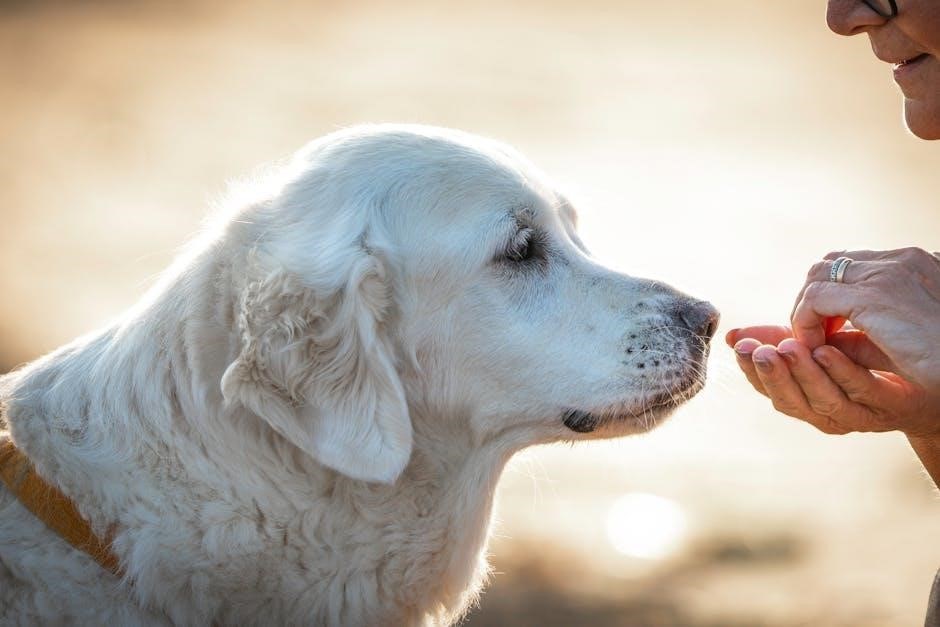Piriton, an antihistamine, is commonly used to treat allergic reactions in dogs. It contains chlorphenamine maleate, helping to alleviate symptoms like itching and sneezing. Always consult a vet before use.
1.1 What is Piriton?
Piriton is a medication primarily designed for human use, containing the active ingredient chlorphenamine maleate, an antihistamine. It is commonly prescribed to relieve symptoms of allergies, such as itching, sneezing, and runny nose. In veterinary medicine, Piriton is sometimes used off-label to treat allergic reactions in dogs. It works by blocking histamine receptors, which are responsible for allergic responses. Piriton is available in tablet and syrup forms, with the syrup being easier to administer for pets. While it is not licensed for canine use, veterinarians may recommend it under specific circumstances. Always consult a vet before giving Piriton to your dog to ensure safe and effective treatment.
1.2 Piriton as an Antihistamine
Piriton functions as an antihistamine by blocking histamine receptors, which are key players in allergic reactions. Histamine is a chemical released during an immune response, causing symptoms like itching, swelling, and sneezing. By inhibiting its action, Piriton effectively reduces these allergic manifestations. In dogs, it is often used to manage skin allergies, hives, and insect bites. The medication works systemically, providing relief within a few hours of administration. While primarily designed for humans, its antihistaminic properties make it a viable option for canines under veterinary guidance. However, precise dosage and administration are crucial to avoid adverse effects, emphasizing the need for professional veterinary advice before use.
1.3 Why Piriton is Used for Dogs
Piriton is commonly used in dogs to manage allergic reactions due to its effectiveness in reducing histamine-related symptoms. It is particularly beneficial for treating skin allergies, insect bites, and hives, which are frequent issues in canines. The medication’s ability to alleviate itching and inflammation makes it a popular choice for pet owners seeking relief for their dogs. Additionally, Piriton can be used to address allergic reactions caused by environmental factors or food sensitivities. While it is not specifically formulated for dogs, its antihistaminic properties make it a safe option under veterinary supervision, ensuring proper dosage and minimizing potential side effects.

Understanding the Dosage Chart
A dosage chart provides clear guidelines for administering Piriton to dogs, ensuring safe and effective treatment. It outlines the recommended dose based on weight and frequency.
2.1 Importance of a Dosage Chart
A dosage chart is essential for ensuring safe and effective use of Piriton in dogs. It provides clear, weight-based guidelines to prevent underdosing or overdosing, promoting accurate administration. By following the chart, pet owners can minimize risks of adverse effects and maximize therapeutic benefits.
2.2 Components of the Dosage Chart
A dosage chart for Piriton typically includes weight ranges, recommended dosages, and frequency of administration. It specifies the mg of chlorphenamine maleate per kg of body weight, ensuring accurate dosing. The chart may also differentiate between tablet and syrup forms, providing equivalent doses. Additionally, it might list guidelines for dogs of various sizes, from small breeds to large dogs, and include notes on adjusting doses based on the severity of allergic reactions. This structured format helps pet owners and vets determine the correct amount to administer, minimizing risks and maximizing effectiveness. Always consult a vet to tailor the chart to your dog’s specific needs.
2;3 How to Read the Dosage Chart

To interpret a Piriton dosage chart, start by locating your dog’s weight in the left column. Match this weight to the corresponding dosage amount, ensuring you select the correct mg per kg. Check whether the dose refers to tablets or syrup, as concentrations may differ. Next, review the frequency column to determine how often the medication should be administered. Pay attention to any footnotes or warnings, such as maximum daily doses or special considerations for specific health conditions. Always cross-reference the chart with your vet’s instructions to ensure accuracy and safety. This systematic approach helps prevent underdosing or overdosing, promoting effective treatment for your dog’s allergies.

Factors Influencing Dosage
Weight, age, health status, and severity of allergic reactions are key factors influencing Piriton dosage in dogs, ensuring safe and effective treatment for their specific needs.
3.1 Weight-Based Dosage
Dosage for dogs is primarily determined by weight, ensuring safety and effectiveness. Veterinarians calculate the appropriate amount based on the dog’s size to prevent under or overmedication. This approach minimizes risks and maximizes therapeutic benefits, making weight a crucial factor in dosing. Always consult a vet to determine the correct dosage for your dog.
3.2 Age and Health Status
A dog’s age and health status significantly influence Piriton dosage. Puppies and senior dogs may require adjusted doses due to differences in metabolism and sensitivity. Additionally, dogs with pre-existing medical conditions, such as liver or kidney disease, may need modified dosages to avoid complications. Veterinarians often tailor the dosage based on these factors to ensure safety and efficacy. It is crucial to disclose your dog’s full health history to your vet to determine the appropriate dose. Neglecting to consider age and health can lead to adverse reactions, emphasizing the importance of professional guidance when administering Piriton to dogs with specific needs or vulnerabilities.
3.3 Severity of Allergic Reaction
The severity of a dog’s allergic reaction plays a critical role in determining the appropriate Piriton dosage. Mild reactions may require a lower dose, while severe reactions, such as anaphylaxis or intense itching, may necessitate a higher dose to effectively manage symptoms. Veterinarians assess the severity by evaluating clinical signs like swelling, respiratory distress, or skin irritation. Adjustments to the dosage are made to ensure the medication is both safe and effective. It is essential to follow the vet’s guidance, as overmedication can lead to adverse effects. The severity of the reaction directly impacts the treatment plan, emphasizing the need for professional evaluation before administration.

Safe Administration of Piriton
Piriton should be administered as directed by a vet, either as tablets or syrup. Ensure accurate dosing based on weight to avoid overdose risks and complications.
4.1 Tablet vs. Syrup: Which is Better?
Choosing between Piriton tablets and syrup depends on your dog’s preferences and needs. Tablets are convenient for precise dosing, while syrup can be easier to administer, especially for smaller dogs. Always follow your vet’s advice for the best option and dosage accuracy, ensuring your dog receives the correct amount for their weight. Both forms are effective, so the choice should be based on what works best for your pet to ensure safe and proper administration of the medication.
4.2 How to Administer Piriton to Dogs
Administering Piriton to dogs requires careful consideration. Tablets can be given directly or hidden in food to mask the taste. For syrups, use a syringe to ensure accurate dosing. Always give the medication with food to minimize stomach upset. Consult your vet before use, as they will determine the correct dosage based on your dog’s weight and condition. Never self-medicate your dog, as improper dosing can lead to health risks. Follow the vet’s instructions precisely for safe and effective treatment. Monitor your dog for any adverse reactions and report them to your vet immediately to ensure the best outcome for your pet.
4.3 Frequency of Administration
Piriton for dogs is typically administered every 8 to 12 hours, depending on the severity of the allergic reaction. Consistency in dosing is crucial to maintain therapeutic effectiveness. Missing a dose can reduce the medication’s efficacy, so it’s important to adhere to the prescribed schedule. However, never give a double dose to compensate for a missed one, as this can increase the risk of side effects. Always follow the frequency recommended by your veterinarian to ensure your dog’s safety and the medication’s effectiveness.

Safety and Precautions
Always use Piriton under veterinary guidance to avoid adverse effects. Monitor for drowsiness or lethargy, and avoid use in dogs with certain health conditions or allergies.
5.1 Potential Side Effects
Piriton for dogs can cause mild side effects, including drowsiness, lethargy, or dry mouth. In rare cases, dogs may experience vomiting or diarrhea. Allergic reactions, though uncommon, can lead to breathing difficulties or skin swelling. If your dog exhibits severe symptoms, seek veterinary care immediately. Monitoring your dog’s behavior after administration is crucial to ensure their safety. Always adhere to the prescribed dosage to minimize the risk of adverse effects. Consulting your vet before use is essential, especially for dogs with pre-existing health conditions or allergies to antihistamines.
5.2 Contraindications
Piriton is contraindicated in dogs with certain medical conditions. Dogs with glaucoma, prostate issues, or urinary retention should avoid Piriton due to its anticholinergic effects. Additionally, dogs with severe liver or kidney disease may require adjusted dosages. Pregnant or lactating dogs should only be treated under strict veterinary supervision. Allergic reactions to Piriton or its active ingredient, chlorphenamine maleate, are rare but possible. Pre-existing heart conditions or high blood pressure may also necessitate caution. Always inform your vet of your dog’s complete health history before administering Piriton to ensure safe usage.
5.3 Overdose Risks
Overdosing on Piriton can lead to severe health complications in dogs. Symptoms may include hyperactivity, agitation, vomiting, diarrhea, increased heart rate, and in extreme cases, seizures or respiratory distress. If you suspect an overdose, contact your veterinarian immediately. Treatment may involve supportive care to manage symptoms and reduce absorption of the medication. Prevention is key—always adhere to the prescribed dosage and monitor your dog’s response. Never increase the dose without veterinary approval. Overdose risks highlight the importance of strict adherence to the dosage chart and professional guidance to ensure your dog’s safety and well-being.

Veterinary Guidance
Consulting a veterinarian is essential for determining the correct dosage and ensuring safe administration. They provide personalized guidance, monitor for side effects, and adjust treatment as needed.
6.1 Why Veterinary Consultation is Crucial
Veterinary consultation is essential to ensure safe and effective use of Piriton for dogs. A vet will assess your dog’s health, weight, and allergy severity to determine the correct dosage. They can also identify potential risks, such as pre-existing conditions or drug interactions, that may affect treatment. Without professional guidance, incorrect dosing could lead to adverse effects or overdose. Vets tailor recommendations to your dog’s specific needs, ensuring the medication is both safe and effective. Additionally, they monitor your dog’s response and adjust treatment as necessary. Always consult a veterinarian before administering Piriton to your dog.
6.2 Tailoring Dosage to Your Dog’s Needs
Tailoring Piriton dosage to your dog’s specific needs ensures effectiveness and safety. Factors like weight, severity of allergies, and overall health are critical. Vets often adjust doses based on these variables to avoid under or over-dosing. For example, smaller breeds may require lower doses, while larger dogs need higher amounts. Age and pre-existing conditions, such as liver or kidney issues, also influence dosage. A personalized dosage chart, created by your vet, helps track and adjust treatment. Regular monitoring ensures the medication remains effective without causing harm. Tailoring dosage prevents potential risks and maximizes therapeutic benefits for your dog.
6.3 Monitoring Your Dog’s Response
Monitoring your dog’s response to Piriton is essential for safe and effective treatment. Look for improvements in allergy symptoms like reduced itching or sneezing. Also, watch for side effects such as drowsiness or increased heart rate. Vets recommend regular check-ups to assess tolerance and adjust dosages. Tracking your dog’s progress helps ensure the medication works without causing harm. Keep a record of symptoms, dosage, and any adverse reactions to share with your vet. This collaborative approach ensures your dog receives optimal care and minimizes potential risks associated with Piriton use.

Legal and Ethical Considerations
Using Piriton for dogs raises legal and ethical issues. It’s an off-label human medication, requiring veterinary approval to ensure safe and responsible administration for your pet.
7.1 Off-Label Use of Human Medications
Using human medications like Piriton for dogs is considered off-label, meaning it’s not FDA-approved for veterinary use. While vets may prescribe it, this practice is legal but requires professional guidance. Owners must consult a veterinarian to ensure safe and effective administration, as improper dosing can lead to risks. Piriton, though commonly used, lacks official veterinary approval, making it crucial to follow expert advice. This highlights the importance of responsible off-label use to protect animal health and well-being.
7.2 Legal Implications of Self-Medication
Administering Piriton to dogs without veterinary guidance can have legal consequences. Self-medication may violate animal welfare laws, as improper dosing can harm pets. In many regions, giving human drugs to animals without professional advice is discouraged and may lead to legal action if it results in harm. Owners risk facing penalties if their actions are deemed negligent. Always consult a vet to ensure compliance with legal standards and safeguard your dog’s health. Legal implications emphasize the importance of adhering to professional veterinary advice when using medications like Piriton for dogs.
7.3 Ethical Responsibility of Pet Owners
Pet owners have an ethical duty to ensure their dogs receive safe and appropriate care. Using Piriton without veterinary guidance can compromise welfare and trust in the human-pet relationship. Ethical responsibility demands prioritizing professional advice over self-medication, especially with human drugs. Owners must balance cost and convenience with the potential risks of improper dosing. Acting responsibly ensures the well-being of pets and upholds the moral obligation to provide compassionate care. Always seek veterinary consultation to align with ethical standards and safeguard your dog’s health effectively.

Creating a Dosage Chart
Develop a personalized chart with your dog’s weight, dosage, and administration frequency. Include vet-recommended guidelines for accurate and safe Piriton use; Ensure clarity and precision always.
8.1 Steps to Develop a Personalized Chart
To create a dosage chart, start by consulting your veterinarian to determine the correct Piriton dosage for your dog based on their weight and health status. Next, gather essential information such as the recommended dosage per kilogram, administration frequency, and any specific instructions. Organize this data into a clear, easy-to-read table or document. Include columns for weight ranges, corresponding dosage amounts, and frequency of administration. Add notes for special considerations, such as potential side effects or contraindications. Finally, review and update the chart with your vet to ensure accuracy and safety for your dog.
8.2 Including Essential Information
Your Piriton dosage chart should include your dog’s name, weight, and breed to ensure personalized dosing. List the recommended dosage in milligrams or milliliters, along with administration frequency, such as once or twice daily. Note the form of Piriton being used, whether it’s tablets or syrup. Include the vet’s contact information and any specific instructions tailored to your dog’s health conditions. Add warnings about potential side effects and overdose risks. Finally, leave space for updates or adjustments based on your dog’s response and vet recommendations. This ensures the chart remains a reliable reference for safe administration.
8.3 Sharing the Chart with Your Vet
Sharing your personalized Piriton dosage chart with your vet is crucial for ensuring your dog’s safety and treatment effectiveness. Your vet can review the chart to confirm accuracy and provide feedback. Regularly update the chart with any changes in dosage or administration frequency based on your vet’s advice. This collaboration helps maintain continuity in your dog’s care. Additionally, sharing the chart during check-ups allows your vet to monitor your dog’s response to Piriton and make necessary adjustments. Open communication with your vet ensures your dog receives the best possible care and minimizes risks associated with medication use.
9.1 Summary of Key Points
Piriton is an effective antihistamine for treating allergic reactions in dogs, but its use requires strict adherence to a dosage chart and veterinary guidance. The medication, containing chlorphenamine maleate, helps alleviate symptoms like itching and sneezing. Proper administration is crucial, with dosages based on the dog’s weight and severity of the reaction. Consulting a vet ensures safety and avoids potential side effects or risks of overdose. Monitoring your dog’s response is essential to adjust treatment as needed. Always prioritize responsible use to ensure your dog’s health and well-being.
9.2 Final Thoughts on Piriton for Dogs
Piriton can be a valuable tool in managing allergies in dogs, but its safe and effective use hinges on careful veterinary oversight. While it’s effective for mild to moderate reactions, it’s not a substitute for professional medical advice. Owners must adhere to the prescribed dosage chart, tailoring administration to their dog’s specific needs. Monitoring for side effects and adjusting treatment as necessary ensures optimal outcomes. Responsible use, guided by veterinary expertise, maximizes benefits and minimizes risks, promoting the overall health and comfort of your pet.
9.3 Encouragement for Responsible Use
Responsible use of Piriton for dogs is crucial for their safety and well-being. Always consult a vet before administering to ensure proper dosage and avoid potential risks. Regular monitoring of your dog’s response helps in adjusting treatment effectively. By adhering to professional guidance, you can maximize the benefits of Piriton while minimizing side effects. Prioritizing your pet’s health through informed and cautious use fosters trust and ensures their comfort. Remember, Piriton is a tool best used under expert advice, reinforcing the importance of collaboration with your veterinarian for your dog’s care.

References and Further Reading
Consult official veterinary guidelines and trusted sources for accurate dosage charts and safety protocols. Access the Piriton for Dogs Dosage Chart PDF for detailed information.
- Official veterinary guidelines
- Peer-reviewed studies on antihistamines
- Reputable pet health websites
10.1 Reliable Sources for Dosage Information
For accurate dosage information, consult official veterinary guidelines, peer-reviewed studies, and reputable pet health websites. Trusted sources include the Piriton for Dogs Dosage Chart PDF, which provides detailed instructions tailored to your dog’s weight and health status. Veterinary associations and licensed animal health platforms also offer reliable data. Always cross-reference with your vet’s advice to ensure safety and efficacy. Official pharmaceutical resources and academic journals are additional credible options for understanding proper administration.
- Official veterinary guidelines
- Peer-reviewed studies on antihistamines
- Reputable pet health websites
- Pharmaceutical resources
10.2 Additional Resources on Dog Health
Beyond dosage charts, explore comprehensive dog health resources for a holistic understanding. Websites like the American Kennel Club and PetMD offer detailed guides on allergies, nutrition, and wellness. These platforms provide insights into managing your dog’s overall health, including dietary advice and exercise routines. Additionally, consult the American Veterinary Medical Association for evidence-based practices. These resources complement the dosage chart by addressing broader aspects of your dog’s care, ensuring a well-rounded approach to their health; Regular check-ups with your vet and staying informed through credible sources are key to responsible pet ownership.
- American Kennel Club
- PetMD
- American Veterinary Medical Association
10.3 Importance of Staying Informed
Staying informed is crucial for responsible pet care, especially when using medications like Piriton. Dosage recommendations can evolve as new research emerges, and being updated ensures safe and effective treatment. Informed pet owners can recognize potential side effects and understand when to seek veterinary help. Regularly reviewing credible sources, such as veterinary guidelines or trusted pet health websites, helps in making informed decisions. This proactive approach not only safeguards your dog’s health but also fosters a stronger bond between you and your pet. Always prioritize knowledge to provide the best care possible.
